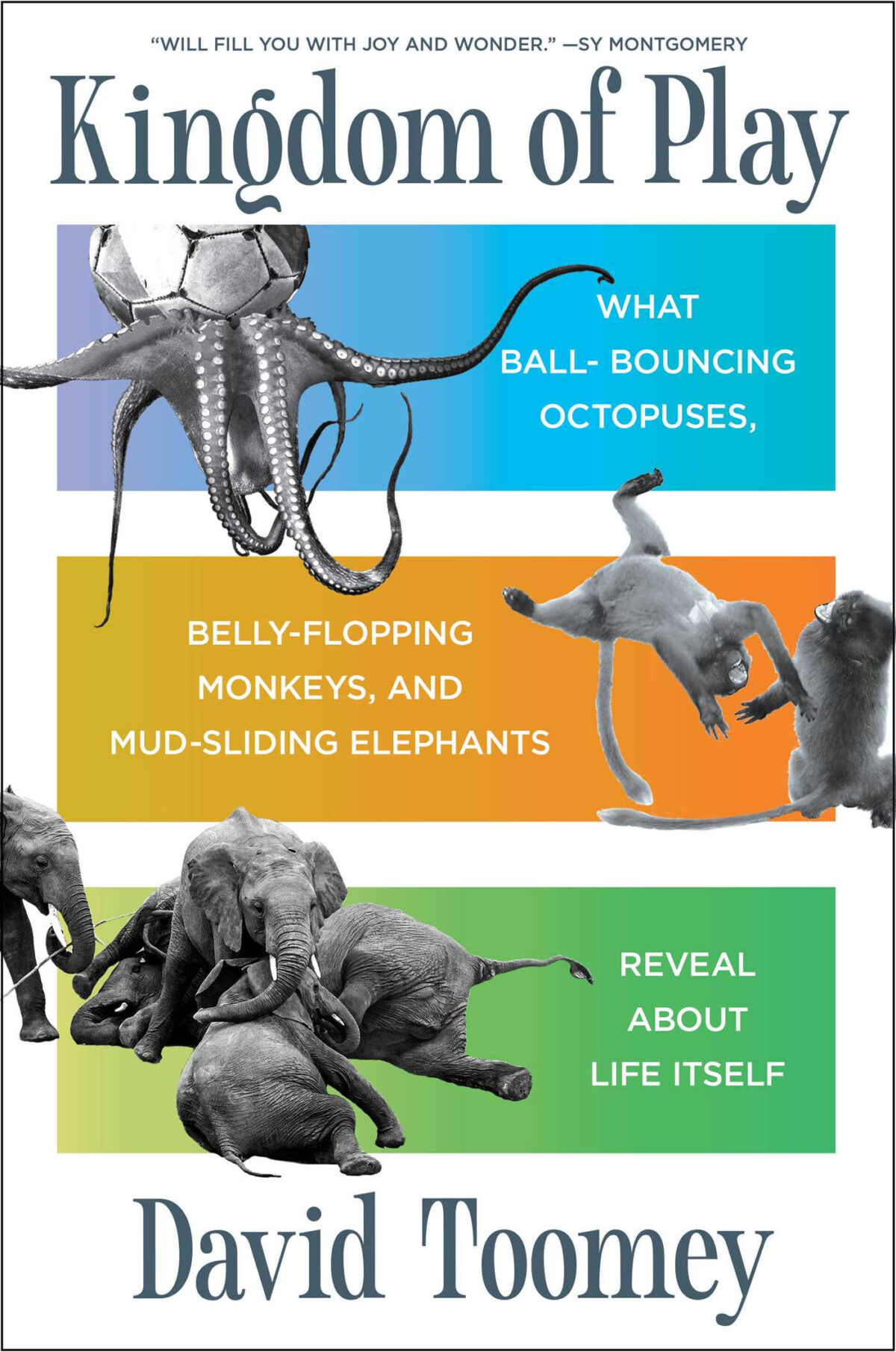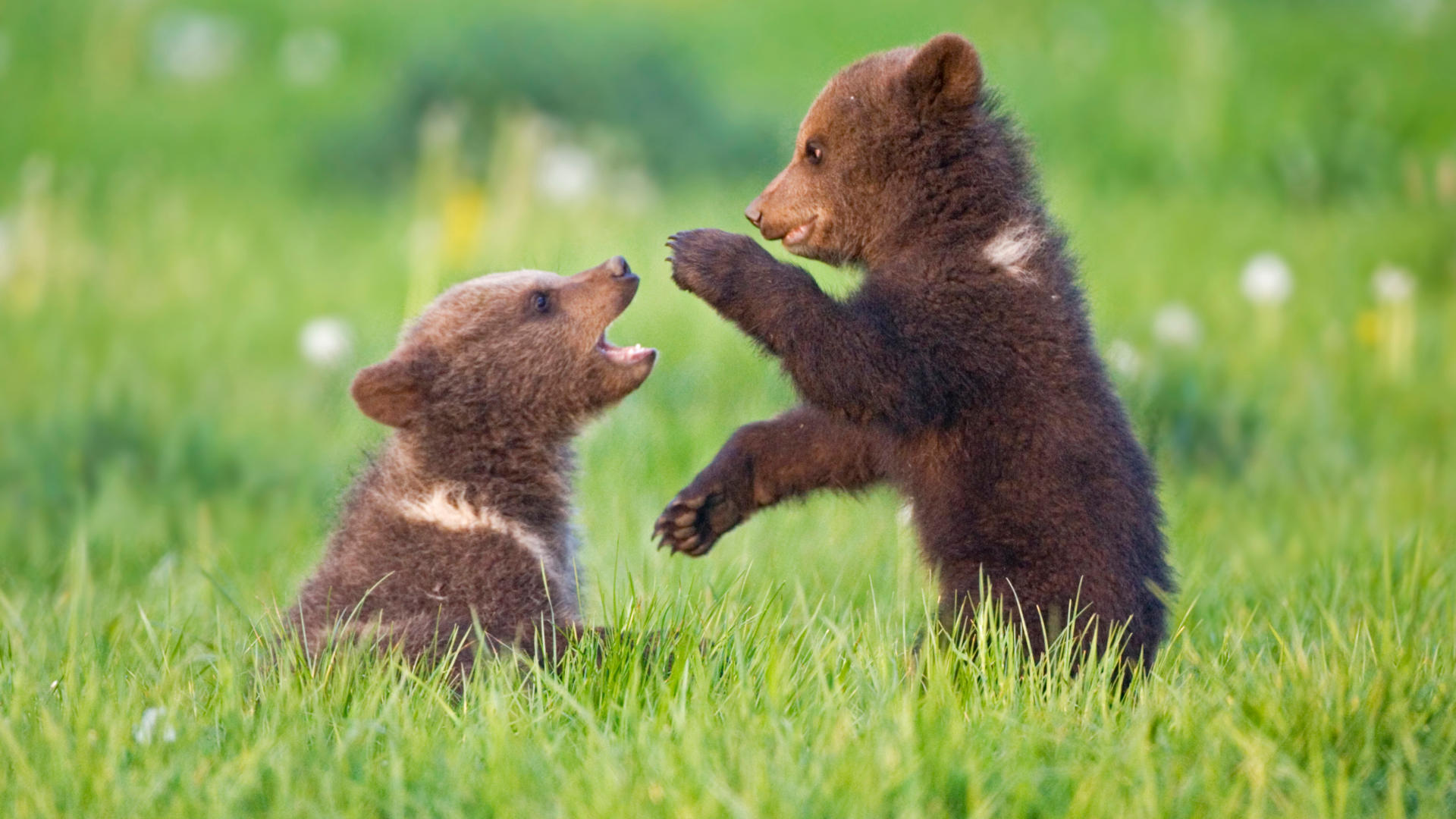Young adult ravens dive and turn by tucking in one wing, spreading the wing again, and turning back. They roll over midflight and chase one another, “dive-bombing” and feinting in and out of one another’s way. A bottlenose dolphin witnessed its companions being taught to tail-walk for a public aquarium performance and, after being released into the wild, began to tail-walk unprompted; to the astonishment of researchers, its wild companions began to tail-walk, too. Elephants have been seen sliding down muddy slopes, some on bellies, some on backsides.
All these behaviors are play, and they present a problem to the scientists who study animal behavior known as ethologists. Since play takes time and energy, and since it can be dangerous, most ethologists assume that play must help an animal to survive or reproduce, and that it must have one or more adaptive advantages precisely because it has so many obvious disadvantages. Yet they have not agreed upon what those advantages might be.

The accompanying article is excerpted and adapted from “Kingdom of Play: What Ball-Bouncing Octopuses, Belly-Flopping Monkeys, and Mud-Sliding Elephants Reveal about Life Itself,” by David Toomey, to be published next week by Scribner.
Play is not the only animal behavior with an adaptive advantage that ethologists find mysterious. They are also puzzled by the adaptive advantage of dreaming. As it happens, play and dreaming are much alike. One researcher has drawn those similarities into rather strict alignment.
Kelly Bulkeley is a psychologist of religion and director of the Sleep and Dream Database, a digital archive and search engine for the scientific study of dreams. Bulkeley thinks it is no happenstance that dreaming looks like play — he believes it is play. More precisely, it’s an imaginative sort of play enacted within the subject’s mind.
The idea he calls the “play theory of dreaming” draws upon human psychology and evolutionary biology. It makes use of work of Gordon Burghardt, an Alumni Distinguished Service Professor in the departments of psychology and ecology & evolutionary biology at the University of Tennessee, Knoxville. A longtime student of animal play, Burghardt has derived a comprehensive definition of play that can be used to identify play in animals like turtles that, many assume, don’t play.
Burghardt says play in any animal is defined by several characteristics. It does not directly fulfill any function related to survival or reproduction. It is voluntary and in no way compelled by forces outside the animal. Its movements are repeated but varied. And it occurs only when the animal is healthy, safe, and well-fed.
With only slight adjustments, says Bulkeley, Burghardt’s definition might as easily describe dreaming. Dreaming has no obvious or direct role in survival or reproduction. Dreams may be affected by forces outside them, but they are produced by the mind and so in that sense are voluntary. They repeat, but with variations. The conscientious student’s nightmare — being utterly unprepared and late for a final exam — recurs, but with each iteration details are varied — different final exams in different classrooms. Since an animal can sleep undisturbed only when it is healthy, safe and well-fed, and can dream only when it is sleeping, it can dream only when it is healthy, safe and well-fed.
Since scientists cannot see animal dreams, they cannot study them directly. They can, however, study animal dreaming by observing a dream’s outward manifestation: a dream-enacting behavior. A sleeping dog may move its legs as if it were running and produce a hoarse, half-suppressed bark. In his 1851 work “The Passions of Animals,” naturalist Edward Thompson observed, “When the impressions of the dream assume a particularly vigorous and distinct character, they affect the slumbering voice and limbs, and thus prove most satisfactorily and clearly that animals really do dream.” He alluded to accounts of dreaming behavior in horses, elephants, and several species of birds — among them storks, canaries, and eagles. Charles Darwin, drawing on his own observations and those of others, concluded, “Probably all the higher animals… have vivid dreams.”
But exactly what are dogs, horses, and canaries dreaming about? To learn what humans dream, researchers have traditionally relied on a report from the dreamer upon waking, a practice not feasible with subjects unable to provide such a report. But there may be other ways.
Human talk in sleep is termed somniloquy. Its brief utterances and fragments of sentences are often too incoherent to serve as a report on any dream, but may nonetheless give hints as to its nature. Somniloquy is a remarkable behavior, and one we may add to the ever-lengthening list of those not unique to humans. The more loquacious species of birds also talk in their sleep. As somniloquy now offers insights into the dreams of humans, so it might one day offer insights into the dreams of birds.
With slight adjustments, one definition of play easily describes dreaming: It has no obvious role in survival or reproduction, it can be considered voluntary, and dreams repeat, but with variations.
Several studies of dreams have used electroencephalography, the measurement and recording of electrical activity — what are termed neural firing patterns — in different parts of the brains of human subjects. One such study found that a subject’s neural firing patterns during sleep — thought to be manifestations of dreaming — are often identical to neural firing patterns that occurred during that subject’s waking experiences shortly before.
The suggestion is that some dreams reactivate or replay recent memories. If this is what’s happening, then the phenomenon suggests intriguing possibilities for research. By comparing such patterns in a chimpanzee when it’s awake and again when it’s sleeping, for example, neuroscientists might learn not only that the chimpanzee is dreaming, but also what it’s dreaming about.
Like play, dreaming is patently disadvantageous: an imprudent use of time and energy at best, and downright dangerous at worst. Yet since many animals dream, evolutionary biologists assume that it must have adaptive advantages. There are many ideas as to what they might be. Since human dreaming is easiest to study, it’s been the focus of most.
One of the most widely accepted theories at present is the threat simulation theory, put forth in 2000 by Finnish researcher Antti Revonsuo. It bears resemblance to a longstanding idea of play’s adaptive advantage — the practice hypothesis, the idea that play serves as rehearsal for adult behaviors. Revonsuo posits that the adaptive advantage of dreams that contain frightening elements — such as dreams in which the dream self is chased or attacked — are simulations of possible threats in waking life and provide exercise for the cognitive mechanisms necessary to perceive and avoid them. Another theory of dreaming is the social simulation theory, which explains some dreams as an “immersive spatiotemporal simulation.”
Or, in the words of one paper, “a simulation of human social reality, simulating the social skills, bonds, interactions, and networks that we engage in during our waking lives.” This, too, resembles a longstanding idea of play’s adaptive advantage — the social cohesion hypothesis —the idea that play enhances social competence, social negotiation, social assessment, and social manipulation.

In 2001, ethologists Marek Spinka, Ruth Newberry, and Marc Bekoff published an article positing another adaptive advantage of play. “We hypothesize,” they wrote, “that a major ancestral function of play is to rehearse behavioral sequences in which animals lose full control over their locomotion, position, or sensory/spatial input and need to regain those faculties quickly.” In other words, natural selection might have evolved in animals a desire to put themselves in situations where they will be thrown off-balance so that they might learn to recover. They called their idea “training for the unexpected.”
Spinka and company posit that animals welcome the unexpected, and that some, finding no unexpected in the offing, may create their own. Something similar may occur in dreams, when we humans create our own unexpected. In a dream, we might open a door and be surprised by what’s behind it. That door and the thing behind it were created in the dream by us — or, more specifically, by our unconscious. In such a dream we are both producing the surprise and being surprised by it.
Spinka and colleagues note that an animal at play may self-handicap — deliberately put itself in a disadvantageous and vulnerable position. Self-handicapping certainly figures in many dreams. The dream of the student whose dream self is unprepared doesn’t end with that realization. Quite often that’s only where the dream begins. It may continue with the dream self obliged to begin the exam.
If dreams do serve as a rehearsal for some eventuality in our waking lives, we might wonder why so many dreams seem to have so little to do with those lives. Of what practical use is a childhood memory of a place we’ll never visit again or a meeting with a person long dead? What might we make of some other dreams that seem to have nothing whatsoever to do with our waking existence, past or present? Dreams that are so bizarre, so utterly and categorically surreal, that there’s no conceivable eventuality for which they might serve as practice?
One suggestion is that some dreams reactivate or replay recent memories. If this is what’s happening, then the phenomenon suggests intriguing research possibilities.
Perhaps some dreams are not rehearsals. Perhaps they are the products of a mind released from the constraints of reality and so able to freely explore and imagine. In dreams, says neuroscientist Matthew Walker, “No longer are we constrained to see the most typical and plainly obvious connections between memory units,” and thus liberated “the brain becomes actively biased toward seeking out the most distant, nonobvious links between sets of information.” In dreams we are attracted to abstractions, to novelty and hyperassociativity We are, one might say, more playful.
That playfulness is not lost upon waking. Research subjects roused from REM sleep (and so perhaps from a dream) solve word puzzles faster than they do when fully awake, and evidently with less deliberation and more intuition. There are innumerable examples of unconscious inspiration. Paul McCartney came upon the melody for “Yesterday” in a dream.
As for dreaming and creativity in animals? Evidence suggests that one species finds inspiration much as the bassist from Liverpool did. Zebra finch sing when they are sleeping. One study discovered that while they sleep, their brains spontaneously reproduce the activation patterns they make when they sing during the day — a finding that strongly suggests they are dreaming about singing. More astonishing is that their subsequent waking songs are nearer mature song — which is to say, improved. It seems that zebra finches not only sing in their sleep. They rehearse.
Play offers a means to escape and transcend not only social and cultural constraints. In the mind of the player, it’s a means to escape and transcend physical constraints — the body, even space and time. In play, that escape may be qualified; in dreams, it is complete.
Fans of pro wrestling are aware that any given match is not real fighting, but a performance. When they cheer and jeer, they participate in that performance, making for communal pretending. The wrestlers and fans are aware of two states of affairs — one real, another illusory — and as the match proceeds, they direct that awareness from the real to the illusory and back again.
One of the first investigators into animal play, German philosopher and psychologist Karl Groos, noted that many animals are capable of the same behavior. In his 1896 book “The Play of Animals,” published in German as “Die Spiele der Thiere” in 1896, he writes, “If, then, in conscious make-believe, in the young dog, for example, that begs his mistress to reach out her foot and then falls upon it with every sign of rage, but never really biting it, the connection between the pretended I and the real I underlying it is preserved in spite of the division of consciousness.”
Owing to the dual awareness of a playing animal, like that of the dog who feigns biting his mistress’s foot, the player always remains aware of the world outside its play. Like a bird tied to a string, it can only fly so far. But dreaming may be different. It’s true that a dual consciousness exists in waking dreams, that is, dreams in which dreamers know they are dreaming. It’s also true that the waking world may intrude upon and affect dreams, as when a noise is woven into a dream without interrupting it. But in most dreaming the world outside is left behind, that string is cut, the bird is released.
In Bulkeley’s view, dreaming is play enacted within the mind and freed of the body, and so freed of the body’s needs and limitations. A compelling view to be sure. If dreaming is disembodied play, then perhaps play is embodied dreaming. If in dreaming we are playing without our bodies, then perhaps in playing we are using our bodies to dream.
David Toomey is an English professor at the University of Massachusetts, Amherst, where he teaches courses in writing and in the history of science. He is the author of several nonfiction books, including “Weird Life” and “The New Time Travelers.”











Comments are automatically closed one year after article publication. Archived comments are below.
I haven’t read the book and I realize this is only an excerpt but I was surprised that in your section about the purpose/function of dreams there was no mention of using metaphor or analogy to explain the meaning of the dream content and thus provide context and meaning for the application of it to waking life. Just a thought.
And very good thought! In fact, the excerpt is from the only chapter in the book that involves dreams, and it deals with only two relatively recent hypotheses about them – and neither considers metaphor, as Freud and many others have. But your query has me wondering – do animals dream in metaphor? If sophisticated language is necessary for metaphor, then perhaps not. But female chimps have dolls made of bundles of branches. Seems to me that that’s a kind of metaphor – no language needed. I’m afraid that that’s about the limit of my knowledge of animal dreams and metaphor – although your query has made me want to find out more. If researching this book has taught me anything, it’s that we humans continually underestimate non-human animals.